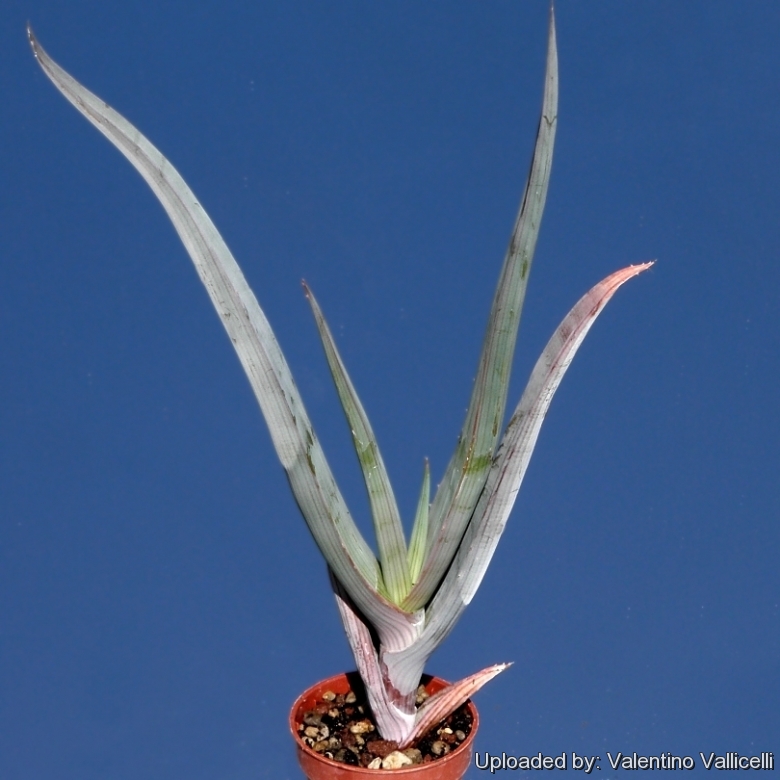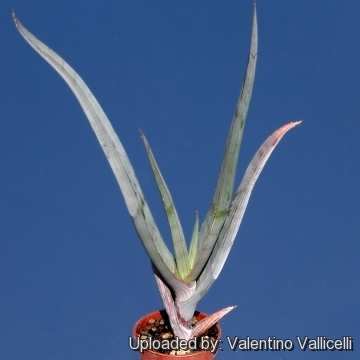




Your support is critical to our success.

Origin and Habitat: Ceres, Clanwilliam and Vanrhynsdorp areas in the Cape Province.(Cedarberg, Botterkloof , Calvinia and adjacent mountains) north-western Cape South Africa.
Type locality: Olifants River valley north of Clanwilliam.
Habitat: It is is restricted to small colonies in very dry, rocky places, rocky sandstone slopes and rocky valleys growing side by side with Cotyledon orbiculataSN|492]]SN|492]]. Rainfall is in winter.
Synonyms:
- Aloe comosa Marloth & A.Berger
ENGLISH: Clanwilliam Aloe
Description: Aloe comosaSN|708]]SN|708]] is a distinctive single-stemmed succulent shrub 2-3 m tall, but when in flower reaches a total height of 5 metres. The tall inflorescence bears attractive ivory-pink flowers.
Stem: Single, unbranched, old leaves persisting on the stem and forming a tangled skirt or beard.
Leaves: Glabrous, narrow, blade-like, lanceolate, erect or spreading, gracefully recurved towards the tips, about 600-700 mm long, and 120 mm wide, distinctly bluish-grey, with subtle thin brownish longitudinal stripes, the underside is bluish green. Often the leaves take a purplish tinge, especially on in full sun. Lamina is involute. Margins entire, finely toothed with spiny, tooth-like, brown-red thorns 1-2 mm long and 5-10 mm apart. The fleshy blades have a whorled leaf insertion as they emerge from the rosette which sits on top of the erect stem.
Inflorescence: This plant produces 1 to 3 slender racemes per rosette, simple, (occasionally branched), very tall (1-3 m hight), with flowers hold closely pressed against the stalk and forming a dense spike up to 2,5 m tall and 20 cm in diameter, the spike is characteristically bi-coloured pale creamy-white below and darker-pink above. Bracts, up to 40 mm long. In the bud they are imbricated at the topof the inflorescence.
Flowers: Greenish-white or ivory-coloured (occasionally deep pink), up to 40 mm long and somewhat narrowed at the base, ovary expanded and constricted in the middle with a diameter of 12 mm. Pedicel about 20 mm in length nearly erect. Tepals almost free about 200 mm long. Stamens and pistil protruding about 10-12 mm. Buds, bulbous, ovoid, dull pink.
Blooming season: Summer (in southern hemisphere December-January)
Chromosome number: 2n = 14
Notes: Aloe comosa is one of those tree aloe aloes that retains dead leaves. This dead-leaf retention protected bare bark from the sun during the day and the cold at night, and also the spiny mass of dried leaves could deter unwanted wild life in search for water, nectar, or seeds. On the other hand dead-leaf retention provide thick, fire resistant bark in a fire-prone habitat.
Bibliography: Major references and further lectures
1) Urs Eggli “Illustrated Handbook of Suculent Plants: Monocotyledons” Springer, 2001.
2) Susan Carter, John J. Lavranos, Leonard E. Newton, Colin C. Walker “Aloes. The definitive guide.” Kew Publishing, Royal Botanic Gardens, Kew 2011, ISBN 978-1-84246-439-7,
3) Gideon F. Smith, Colin C. Walker, Estrela Figueiredo “What’s in a name: epithets in Aloe L. (Asphodelaceae) and what to call the next new species.” In: Bradleya. Band 28, 2010, S. 99.
4) Edgar Lamb, Brian Lamb “The Illustrated Reference on Cacti & Other Succulents", Volume 5 Blandford Press, 1978
5) Gordon D. Rowley “The illustrated encyclopedia of succulents” Crown Publishers, 01/Aug/1978
6) John (John C.) Manning “Field guide to fynbos” Struik, 2007
7) Peter Joyce “Flower Watching in the Cape: Scenic Routes Throughout the Year” Struik, 2004
8) Hans Bornman, David S. Hardy “Aloes of the South African veld” Voortrekkerpers, 1971
9) Eve Palmer, Norah Pitman “Trees of Southern Africa, covering all known indigenous species in the Republic of South Africa, South-West Africa, Botswana, Lesotho & Swaziland” Volume 1 A. A. Balkema, 1972
10) Barbara Jeppe “South African aloes” Purnell, 1974
11) Ben-Erik Van Wyk, Gideon Smith “Guide to the Aloes of South Africa” Briza Publ., 1996
12) Yvonne Cave “Succulents for the contemporary garden” Timber Press, 01/Jan/2003
13) Angiosperm Phylogeny Group (2003). "An update of the Angiosperm Phylogeny Group classification for the orders and families of flowering plants: APG II." Botanical Journal of the Linnean Society 141: 399-436
14) Oliver, Ian. Karoo Desert National Botanical Gardens. July 2006. South African National Biodiversity Institute, South Africa. http://www.plantzafrica.com/plantab/aloecomosa.htm
15) Brummitt RK; Powell CE. (1992). "Authors of Plant Names." Royal Botanic Gardens, Kew. ISBN 1-84246-085-4.
16) Bond, W. “Dead leaves and fire survival in Southern African tree aloes”. Oecologia. Vol. 58, Number 1/ April 1983. pg. 110-114. ISSN 0029-8549 (Print) 1432-1939 (Online)
17) Walter C. Holmes & Heather L. White "Aloaceae". in Flora of North America Vol. 26 Page 12, 15, 18, 20, 410. Oxford University Press. Online at Efloras.org.
18) Moran, R. 1992. “Aloe wild in California." Cact. Succ. J. (Los Angeles)” 64: 55-56.
19) Reynolds, G. W. 1982. “The Aloes of South Africa” ed. 4. Rotterdam.

Aloe comosa Photo by: Valentino Vallicelli
The gallery now contains thousands of pictures, however it is possible to do even more. We are, of course, seeking photos of species not yet shown in the gallery but not only that, we are also looking for better pictures than those already present. Read More...
Cultivation and Propagation: It is relatively easy to cultivate under a wide variety of climatic conditions provided it is planted in a well-drained situation given adequate water but not over-watered.
Soil: Grow it in an open sandy-gritty cactus compost, well-drained, with a slightly acidic pH (5-6).
Pots: It needs a relatively shallow pot to accommodate its fibrous roots and provide a very good drainage. It may stay in the same pot for many years.
Watering: Water in moderation. Keep dry in winter or when night temperatures remain below 10° C. Water it less than average if in bigger pots.
Special need: Provide very good ventilation. Nearly all problems occur as a result of overwatering and poor ventilation, especially when weather conditions are dull and cool or very humid.
Fertilization: Light fertilizer seems to boost its growth whenever additional water is given.
Feed them during the growing season with a fertilizer specifically formulated for cactus and succulents (high potash fertilizer with a dilute low nitrogen), including all micro nutrients and trace elements diluted to ½ the strength recommended on the label. They thrive in poor soils and need a limited supplies of fertilizer to avoid the plants developing excess vegetation, which is easily attacked by fungal diseases.
Exposure: It enjoys light-shade. It may be grown in full sun too but protect in summer from afternoon sun, and avoid reflected heat. It will do its best with some sun and become stressed with inadequate light which could result in poor growth and unnatural shape. Direct sunlight along with prolonged drought and make the leaves turn a reddish colour, a sign generally associated with stress.
Hardiness: It likes warmth (recommended minimum winter temperature 5° C) however plants kept perfectly dry can can survive low temperatures, approx. -2° for short periods, but for safe cultivation it is best to avoid freezing temperatures.
Use: This is suited for a non heated green house. It can be also cultivated outdoors in raised beds, terraces if sheltered from winter rain. This aloe continues to be, a particular prize among collectors
Maintenance: Removal of old flower stalks.
Propagation: Propagation is by seed, as it usually do not offsets. Seeds must be sown as fresh as possible. The best time for sowing would be in the spring or summer when temperatures are warm. Use coarse, well-drained sandy soil and cover seeds lightly, then keep moist. Cover the seeds with a fine layer of grit and water from below with a with a long-lasting fungicide, as seedlings are prone to damping off, a fungus that eventually kills the young plants. For the 1-2 weeks cover the pots with a sheet of glass/clear perspex to keep the humidity levels high. Remove the glass and replace it with light shade-cloth and mist once or twice a day for the next two weeks after which most seeds should have germinated. From then on mistings can be reduced to every second and then every third day as the little plants grow. If you have a number of them you could intentionally damage the growing point to see if it will offset, but wait to do that until early spring, when its growing season is beginning.
| Your Actions | |
|---|---|
| Back to Aloe index | |
| Back to Aloaceae index | |
 |
Back to Succulents Encyclopedia index |
Privacy stantement - Terms and conditions - How to cite - About us - Feedback - Donate



